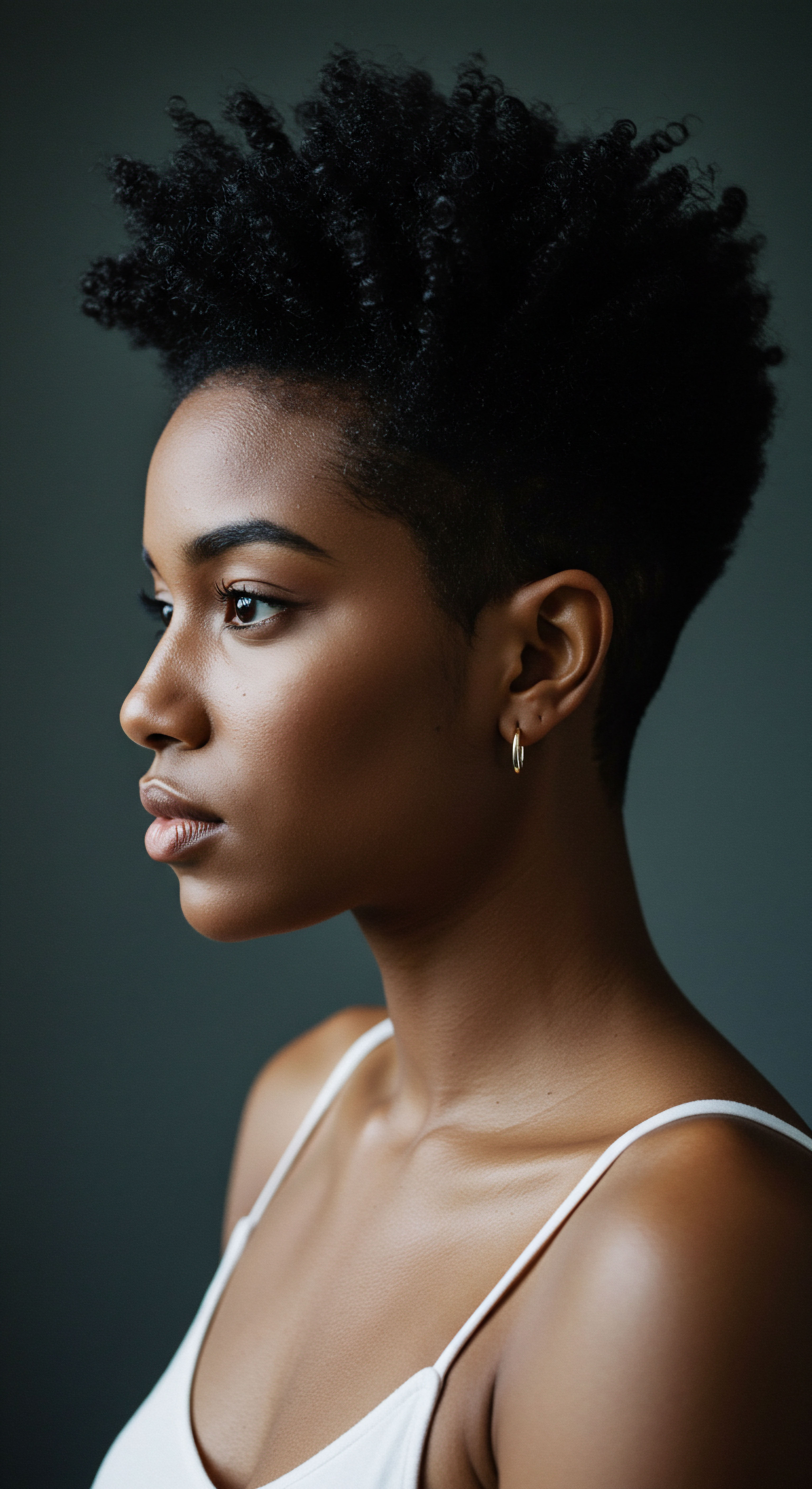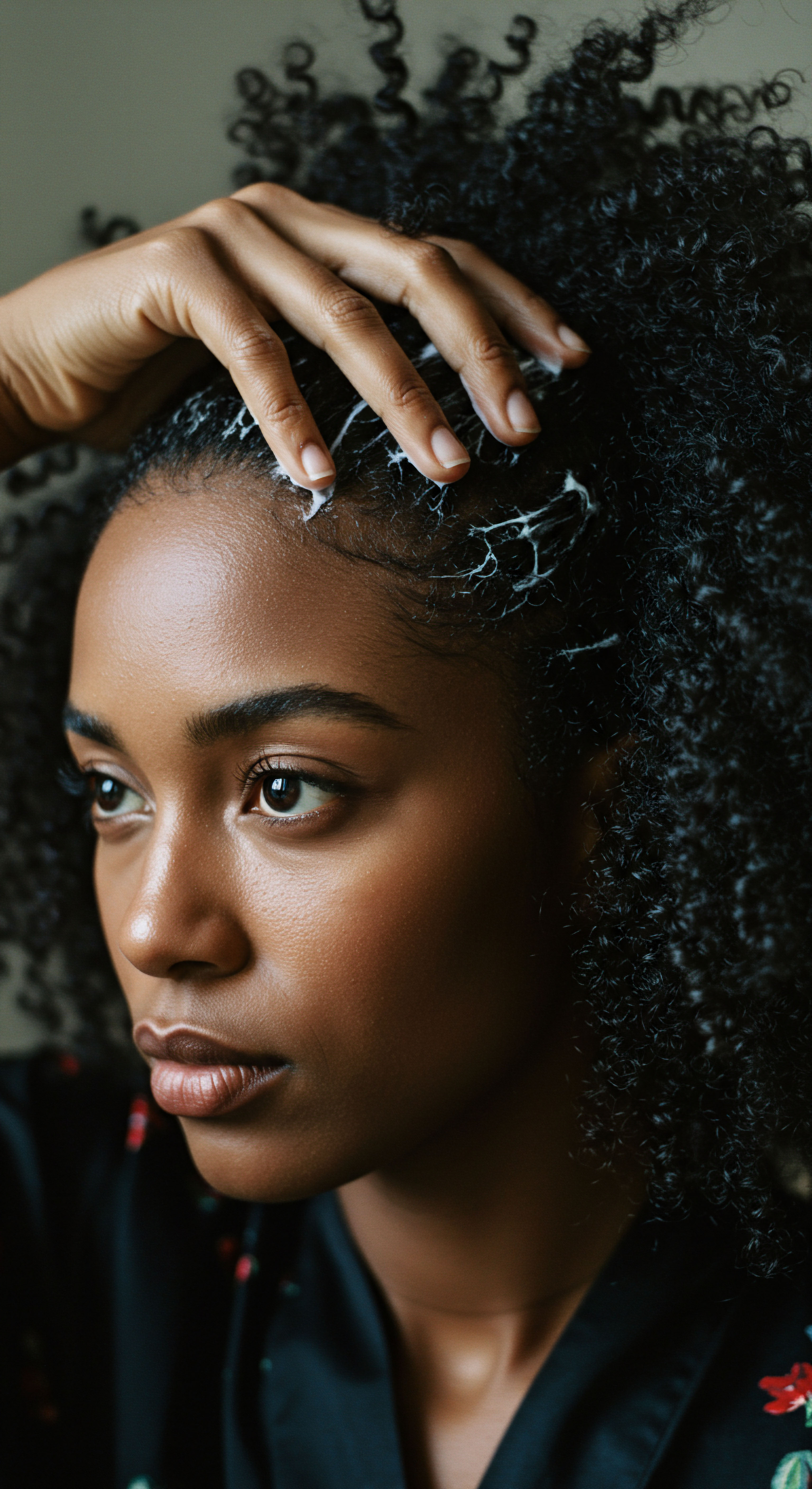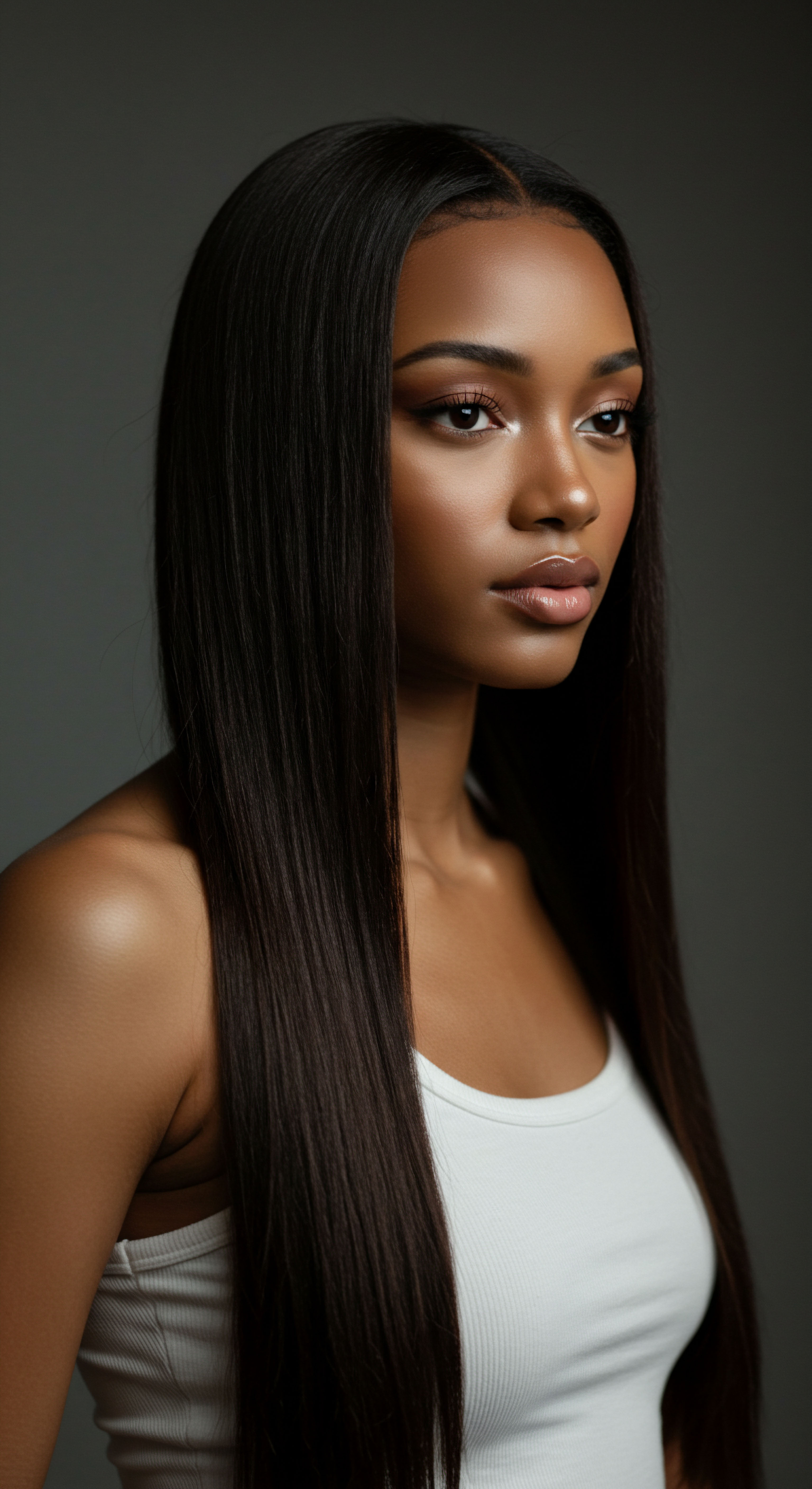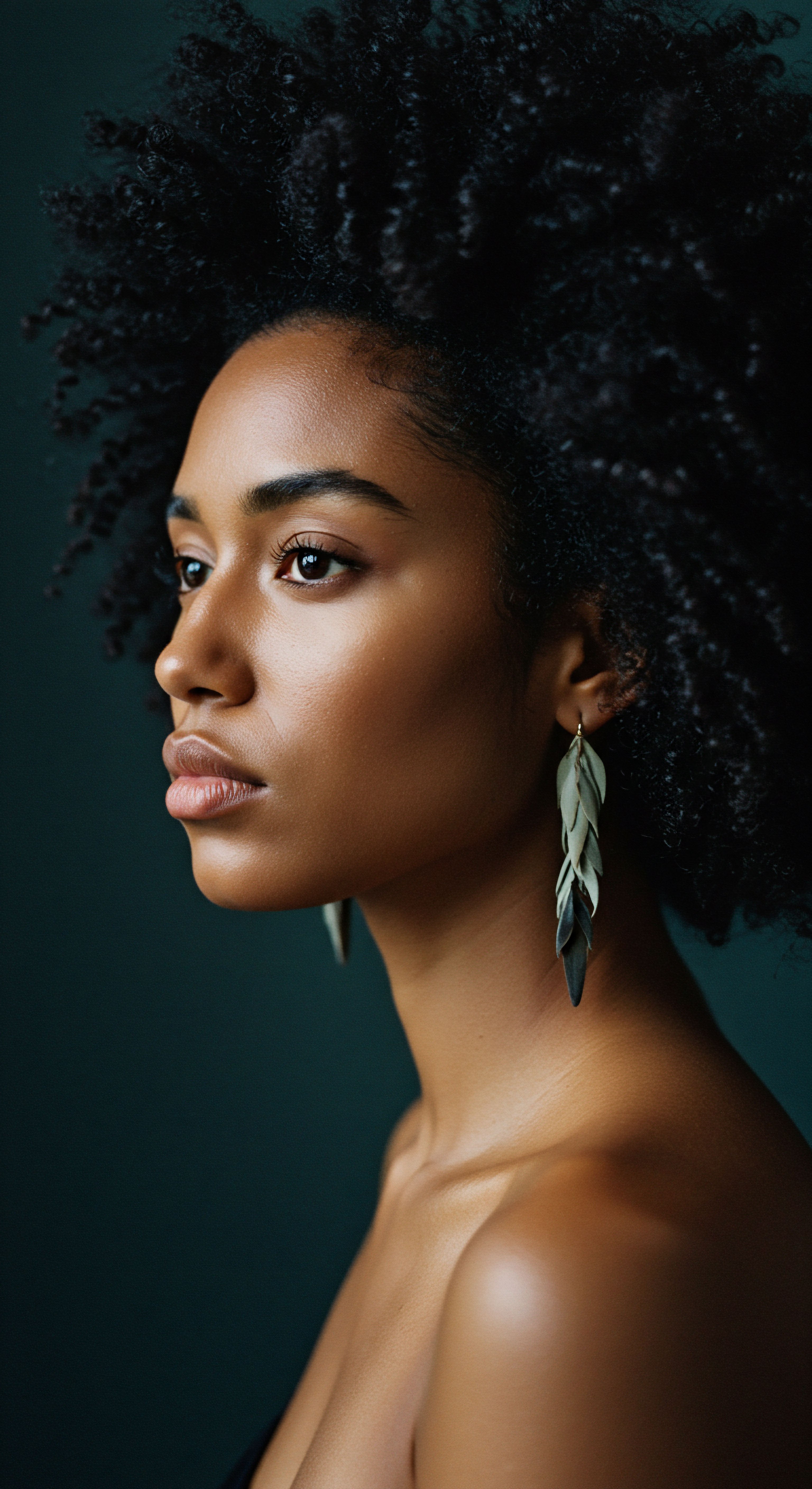
Roots
The quiet rustle of fabric, a familiar comfort against the scalp, often holds more than just a momentary sensation. It carries echoes of generations, a subtle hum of stories whispered through time. For textured hair, the act of wrapping strands in cloth is not merely a practical choice for preservation; it is a profound connection to an enduring cultural legacy, a practice that has gracefully adapted across continents and centuries. This simple gesture, a cloth artfully arranged, stands as a testament to resilience, creativity, and identity.

Ancient Beginnings of Hair Wraps
Across the African continent, from ancient civilizations to vibrant modern communities, hair wraps have held deep meaning. Historical evidence, including hieroglyphics and ancient art, suggests that head coverings were present in ancient Egypt and Nubia, often adorning royalty and signifying status. In West Africa, particularly among groups like the Yoruba, the practice of styling and covering hair with cloth was widespread, with specific names like ‘geles’ in Nigeria or ‘dukus’ in Ghana.
These wraps were not just adornments; they were visual languages. They could communicate a woman’s marital status, her wealth, her ethnic background, or even her emotional state.
Hair wraps, beyond their aesthetic appeal, have served as visual languages across diverse African cultures for centuries.
The materials themselves held significance. Early head coverings utilized locally available fabrics, often rich in texture and color. The deliberate choice of pattern and method of tying could convey a wealth of information to those who understood the local codes. This tradition of symbolic dressing for the head demonstrates a sophisticated understanding of non-verbal communication within these societies, where every fold and drape held a story.

Hair’s Structure and Its Needs
To truly appreciate the protective aspect of hair wraps, one might consider the inherent qualities of textured hair itself. Coiled, curly, and kinky strands possess a unique structure. Unlike straight hair, the cuticle layers of textured hair do not always lie completely flat.
This characteristic can make textured hair more prone to dryness, as moisture can escape more readily. Furthermore, the natural curl pattern can lead to tangling and breakage if not handled with care.
The anatomical realities of textured hair necessitate specific care practices to maintain its health and integrity. Minimizing friction and retaining moisture are paramount concerns. This is where the wisdom of ancestral practices, like hair wrapping, intersects with contemporary understanding of hair science. The softness of certain fabrics, particularly silk and satin, offers a gentle shield, reducing the mechanical stress that daily life and even sleep can place upon delicate coils.

The Language of Hair and Identity
Throughout history, hair has been a powerful marker of identity across many cultures, and for people of African descent, this connection runs particularly deep. Hairstyles could denote tribal affiliation, age, social standing, or even spiritual beliefs. When individuals were forcibly removed from their homelands during the transatlantic slave trade, their traditional hair practices faced immense disruption.
Despite efforts to strip away cultural identity, the act of styling and covering hair became a quiet, yet potent, form of resistance. Hair wraps, often made from simple cloths, served as a means to preserve cultural practices and maintain a sense of self in the face of dehumanization.
- Cultural Markers ❉ Hair wraps in Africa often indicated social status, marital status, or tribal identity.
- Protective Measures ❉ Historically, wraps shielded hair from environmental elements like sun, dust, and heat.
- Resilience Symbols ❉ During periods of oppression, hair wraps became powerful signs of defiance and cultural continuity.

Ritual
The act of wrapping hair, whether for a grand occasion or the quiet of bedtime, is more than a mere routine; it is a ritual. It is a moment of care, a gesture of preservation, and often, a connection to a larger heritage. This section explores the practical wisdom embedded in hair wrapping, examining its evolution from ancient protection to modern-day styling and wellness practices for textured hair. It invites a closer look at how these practices are performed and the tools that support them.

Why Does Wrapping Hair Work So Well?
The effectiveness of hair wraps, especially for textured hair, lies in their ability to address specific vulnerabilities. Textured hair, with its unique curl pattern, is susceptible to tangling and breakage caused by friction. When hair rubs against rough surfaces, such as cotton pillowcases, the delicate cuticle layers can lift, leading to frizz and eventual damage. A smooth surface, like silk or satin, allows hair to glide without resistance, minimizing this mechanical stress.
Beyond friction, hair wraps also play a crucial role in moisture retention. Textured hair tends to be drier than other hair types due to its structure, which can make it more challenging for natural oils to travel down the hair shaft. Wrapping the hair helps to seal in moisture from conditioners and styling products, creating a humid micro-environment that keeps strands hydrated and supple. This is particularly beneficial for maintaining styled hair, extending the life of braids, twists, or even straightened looks.

Hair Wraps and Protective Styling
Protective styles are a cornerstone of textured hair care, designed to minimize manipulation and shield the hair from environmental damage. Hair wraps stand as a simple yet powerful form of protective styling. They offer a versatile solution for managing hair between washes, protecting delicate ends, and preserving intricate styles. The tradition of using wraps as protective coverings dates back centuries, long before modern hair care products existed.
| Material Silk |
| Primary Benefit for Textured Hair Reduces friction, retains moisture, hypoallergenic. |
| Material Satin |
| Primary Benefit for Textured Hair Reduces friction, retains moisture, often more affordable than silk. |
| Material Cotton |
| Primary Benefit for Textured Hair Breathable, but can cause friction and absorb moisture. |
| Material Choosing the right material is essential for maximizing hair protection and health. |

What are the Practical Applications of Hair Wraps in Daily Care?
The practical applications of hair wraps extend beyond mere protection. For many, they serve as a time-saving solution for daily styling. On days when time is short, or when hair requires a break from manipulation, a well-tied wrap can offer a polished appearance while safeguarding strands.
They are also instrumental in applying overnight treatments, ensuring products remain on the hair and do not transfer to bedding. This simple act can transform a nightly routine into a potent opportunity for hair health.
The widespread adoption of bonnets, a specific type of hair wrap, speaks to this practical wisdom. Bonnets, typically made of satin or silk, have become an essential tool for nighttime hair care. Their smooth surface prevents the hair from snagging on pillowcases, reducing tangles and frizz that can occur during sleep. This practice helps to preserve curl definition, prevent breakage, and extend the life of various hairstyles, making mornings easier and hair healthier.
A well-chosen hair wrap offers both practical daily utility and a quiet act of hair preservation.

Relay
The journey of hair wraps, from ancient Africa to contemporary global fashion, is a compelling story of adaptation, resistance, and cultural affirmation. This section explores the deeper societal and psychological layers of hair wrapping, examining its role in challenging oppressive norms, fostering collective identity, and its continued significance in modern wellness. It delves into the intricate interplay of history, identity, and the enduring power of a simple piece of cloth.

Hair Wraps and Acts of Resistance
The cultural background of hair wraps is inextricably linked to periods of immense social upheaval, particularly during the transatlantic slave trade and its aftermath. In the antebellum American South, laws were enacted to strip enslaved and free Black women of their agency, including their right to express themselves through elaborate hairstyles. The infamous Tignon Laws of 1786 in Louisiana, for instance, mandated that Afro-Creole women cover their hair with a simple kerchief or ‘tignon’ to signify their perceived lower social status.
Yet, these oppressive measures often spurred acts of creative defiance. Black women transformed the mandated head coverings into vibrant statements of beauty and rebellion. They adorned their tignons with colorful fabrics, jewels, and ribbons, turning a symbol of subjugation into an assertion of identity and a visual language of resistance. This transformation was a powerful demonstration of agency, a refusal to be confined by imposed limitations.
From enforced subjugation to defiant adornment, hair wraps became a powerful canvas for self-expression and cultural resistance.
This pattern of resistance continued through generations. During the Civil Rights Movement and the Black Power Movement of the 1960s and 70s, head wraps, alongside the Afro hairstyle, became symbols of Black pride and a rejection of Eurocentric beauty standards. They represented a conscious choice to reclaim and celebrate natural Black beauty, defying societal pressures to conform.

The Psychological Impact of Hair Discrimination
The policing of Black hair, historically manifested through laws like the Tignon Laws and continuing through contemporary hair discrimination, has a profound psychological impact. Research indicates that such discrimination, which often favors straightened hair over natural textures, can lead to feelings of inadequacy and diminished self-esteem among Black women. A study on hair and identity in Black culture highlights that “Black women’s hair is inextricably tied to our mental health and serves as a key aspect we must explore as a mental health resource and not something purely aesthetic.” This suggests that practices like hair wrapping, which celebrate and protect natural textures, serve not only a physical purpose but also contribute significantly to mental well-being and self-acceptance. The constant societal pressure to alter one’s natural hair can create a conflict between personal identity and external expectations, underscoring the importance of cultural practices that affirm intrinsic beauty.
Consider the subtle, yet pervasive, psychological toll of constant friction. A study on the benefits of silk and satin for hair notes that “the friction from cotton can increase hair breakage by up to 50% compared to smoother fabrics!” While this statistic speaks to physical damage, the emotional impact of visible breakage and the constant battle against frizz can contribute to feelings of frustration and dissatisfaction with one’s appearance. Hair wraps, particularly those made of silk or satin, directly mitigate this physical damage, thereby indirectly alleviating some of the daily stressors associated with maintaining textured hair. This physical protection becomes a psychological comfort, a quiet act of self-care that builds confidence and reinforces a positive relationship with one’s natural hair.

How do Hair Wraps Contribute to Collective Identity and Heritage?
Beyond individual acts of defiance, hair wraps serve as powerful symbols of collective identity and shared heritage. They are a common visual thread across the African diaspora, connecting individuals to their ancestral roots and to a global community that understands the cultural weight of hair. This shared understanding transcends geographical boundaries, forming a silent language of belonging.
The communal aspects of hair care, historically central to many African societies, also persist through the practice of hair wrapping. While often a solitary act in modern contexts, the knowledge and traditions surrounding wraps are often passed down through families and communities, reinforcing intergenerational bonds. This continuity of practice ensures that the stories, meanings, and techniques associated with hair wraps continue to be relayed from one generation to the next, maintaining a living connection to cultural heritage.
- Tignon Laws ❉ Mandated head coverings for Afro-Creole women in 18th-century Louisiana.
- Reclamation ❉ Black women transformed these coverings into statements of beauty and resistance.
- Modern Affirmation ❉ Today, hair wraps symbolize pride, self-care, and cultural continuity.
The continued prominence of hair wraps in contemporary fashion and beauty spaces reflects a broader movement of cultural reclamation. As more individuals choose to embrace their natural hair textures, the hair wrap stands as a visible declaration of self-acceptance and a celebration of ancestral traditions. It is a powerful reminder that what we place upon our heads can speak volumes about who we are, where we come from, and the legacy we carry forward.

Reflection
The story of hair wraps for textured hair is not simply a historical account; it is a living testament to human spirit. From the earliest expressions of status and belonging on the African continent to the enforced coverings of enslavement, and ultimately, to their reclamation as symbols of beauty and defiance, these humble pieces of cloth have witnessed profound shifts. They stand as quiet guardians of strands, offering protection and promoting health, yet their deepest significance lies in the enduring narratives they carry.
Each wrap, whether worn for a night’s rest or a public declaration, whispers of resilience, identity, and the timeless art of self-care. It is a continuous conversation between past and present, a soft embrace of heritage that continues to shape our understanding of beauty and belonging.

References
- 1. Sonson. (2021). The History of Headwraps and Black Culture. sonson.
- 2. Wilderness Safaris. (2015). The history & meaning of head wraps across Africa. Wilderness Safaris.
- 3. Leone Culture. (2023). Exploring the Significance Of Headwraps In African Fashion And Traditions. Leone Culture.
- 4. JD Institute of Fashion Technology. (2021). HEADWRAPS ❉ HISTORY AND EVOLUTION. JD Institute of Fashion Technology.
- 5. Griebel, H. B. (1994). The African American Woman’s Headwrap ❉ Unwinding the Symbols. Art, Design, and Visual Thinking.
- 6. Thomas, A. (2018). Sartorial insurgencies ❉ Rebel women, headwraps and the revolutionary Black Atlantic.
- 7. The History of Headwraps ❉ Then, There, and Now. (2024).
- 8. DermNet. Hair care practices in women of African descent.
- 9. Helix Hair Labs. (2023). THE HISTORY OF THE HAIR BONNET. Helix Hair Labs.
- 10. Byrdie. (2022). The Significance and History of Bonnets.
- 11. Chicago Public Library. (n.d.). Celebrating Black Hair ❉ Books for Adults.
- 12. Annie International, Inc. (2023). The Origin Story Of The Bonnet.
- 13. Nourished Springs. (2024). Can Head wraps Serve as a Protective Style for Afro-Textured Hair?
- 14. YANIBEST. (2024). The Satin Bonnet ❉ Embracing History, Beauty, and Diversity.
- 15. Turbie Twist. (2023). The Ultimate Guide to Hair Bonnets ❉ Everything You Need to Know.
- 16. Odele Beauty. (2021). 6 Things Everyone Should Know About Black Hair History.
- 17. Colleen. (2024). The Twisted Strands of Textured Hair History ❉ From Ancient Remedies to Modern Magic.
- 18. Afriklens. (2024). Natural African Haircare ❉ Celebrating the Afro and Braids.
- 19. The Tignon Laws & Black Women’s Creative Resistance. (2024).
- 20. Afriklens. (2024). African Hairstyles ❉ Cultural Significance and Legacy.
- 21. Psych Central. (2022). PsychoHairapy ❉ A Ritual of Healing Through Hair.
- 22. The Epic. (2024). Styling personal identity and expression through hair.
- 23. Esme Luxury. (2024). Silk Hair Wraps in Different Cultures ❉ A Global Perspective.
- 24. C+R Research. (2024). The Connection Between Hair and Identity in Black Culture.
- 25. Hair Care Practices from the Diaspora ❉ A Look at Africa, America, and Europe. (2025).
- 26. Obé Headwear. (2024). Significance of headwraps | Hair care.
- 27. Black Women Radicals. (2020). How Naturals In And Outside The U.S. Maintain What’s On And In Their Crown During A Pandemic.
- 28. Colleen. (2020). The History of Textured Hair.
- 29. Creative Support. The History of Black Hair.
- 30. Chimbiri, K. (2021). The Story of Afro Hair, 5,000 Years of History, Fashion and Styles. Scholastic.
- 31. Sartorial Magazine. (2025). Braids, Locs, and Beyond ❉ The Beauty and History of Protective Styles.
- 32. Wikipedia. Protective hairstyle.
- 33. Dabiri, E. (2020). Twisted ❉ The Tangled History of Black Hair Culture. Harper Perennial.
- 34. CSEP. The Story of Afro Hair.
- 35. New Beacon Books. The Story Of Afro hair; 5000 years of history, fashion and styles.
- 36. Herbs & Oils Haircare Essentials. The History & Power of Protective Styles.
- 37. SkinKraft. (2021). How Does Texturizer Impact Your Natural Hair?
- 38. Érudit. The importance of hair in the identity of Black people.
- 39. QuickTakes. (2025). Student Question ❉ What impact does hair discrimination have on the identity and self-expression of Black women?
- 40. Mimi et Mina. (2023). The Benefits of Silk and Satin for your hair ❉ Hair Wraps and Pillowcases.
- 41. The Power of Hair ❉ Expression, Identity, and Empowerment in the LGBTQ+ Community. (2024).
- 42. Noelle Salon. (2024). Understanding Hair Types and Textures ❉ The Science Explored Boston.
- 43. Turbie Twist. (n.d.). 5 Ways You Can Benefit From Using a Hair Wrap.